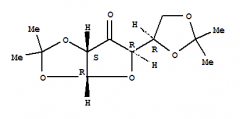- 中文别名:1,2:5,6-二-O-异亚丙基-Α-D-3-呋喃核酮糖
- 中文释义:1,2:5,6-二-o-异亚丙基-alpha-d-ribo-3-己呋喃核糖;1,2:5,6-二-O-异亚丙基-Α-D-3-呋喃核酮糖
- 英文别名:1,2:5,6-Di-O-isopropylidene-α-D-ribo-hexofuranose-3-ulose;
1,2:5,6-DI-O-ISOPROPYLIDENE-α-D-RIBO-3-HEXULOFURANOSE - cas No.:2847-00-9
- 分子式:C12H18O6
- 分子量:258.2677
- 精确分子量:258.11000
- PSA:63.22000
- InChI:The Key: QSRFRZJIRAOQSJ-JZKKDOLYSA-N
- 分子结构式:

物化性质
- 外观与性状:
- 无色非常粘性液体
- 密度:
- 1.268g/cm3
- 熔点:
- 65-70ºC
- 沸点:
- 349.8ºC at 760mmHg
- 闪点:
- 165.4ºC
- 折射率:
- 1.471
- 蒸汽压:
- 0.000152mmHg at 25°C
安全信息
- 外观与性状:
- 无色非常粘性液体
- 密度:
- 1.268g/cm3
- 熔点:
- 65-70ºC
- 沸点:
- 349.8ºC at 760mmHg
- 闪点:
- 165.4ºC
- 折射率:
- 1.471
- 蒸汽压:
- 0.000152mmHg at 25°C
MSDS
| Name: | 1 2:5 6-di-o-isopropylidene-alpha-d-ribo-3 -hexulofuranose 98% Material Safety Data Sheet |
| Synonym: | |
| CAS: | 2847-00-9 |
Synonym:
Section 2 - COMPOSITION, INFORMATION ON INGREDIENTS
| CAS# | Chemical Name | content | EINECS# |
| 2847-00-9 | 1,2:5,6-di-o-isopropylidene-alpha-d-ri | 98.0 | 220-646-9 |
Risk Phrases: None Listed.
Section 3 - HAZARDS IDENTIFICATION
EMERGENCY OVERVIEW
The toxicological properties of this material have not been fully investigated.
Potential Health Effects
Eye:
May cause eye irritation.
Skin:
May cause skin irritation.
Ingestion:
May cause irritation of the digestive tract. The toxicological properties of this substance have not been fully investigated.
Inhalation:
The toxicological properties of this substance have not been fully investigated. May cause irritation of the mucous membranes.
Chronic:
No information found.
Section 4 - FIRST AID MEASURES
Eyes: Flush eyes with plenty of water for at least 15 minutes, occasionally lifting the upper and lower eyelids. Get medical aid immediately.
Skin:
Get medical aid. Flush skin with plenty of water for at least 15 minutes while removing contaminated clothing and shoes. Wash clothing before reuse.
Ingestion:
If victim is conscious and alert, give 2-4 cupfuls of milk or water.
Never give anything by mouth to an unconscious person. Get medical aid immediately.
Inhalation:
Remove from exposure and move to fresh air immediately. If not breathing, give artificial respiration. If breathing is difficult, give oxygen. Get medical aid.
Notes to Physician:
Antidote: None reported.
Section 5 - FIRE FIGHTING MEASURES
General Information:
As in any fire, wear a self-contained breathing apparatus in pressure-demand, MSHA/NIOSH (approved or equivalent), and full protective gear. During a fire, irritating and highly toxic gases may be generated by thermal decomposition or combustion.
Extinguishing Media:
Use water spray, dry chemical, carbon dioxide, or appropriate foam.
Section 6 - ACCIDENTAL RELEASE MEASURES
General Information: Use proper personal protective equipment as indicated in Section 8.
Spills/Leaks:
Absorb spill with inert material (e.g. vermiculite, sand or earth), then place in suitable container. Clean up spills immediately, observing precautions in the Protective Equipment section. Provide ventilation.
Section 7 - HANDLING and STORAGE
Handling:
Wash thoroughly after handling. Remove contaminated clothing and wash before reuse. Use with adequate ventilation. Avoid contact with eyes, skin, and clothing. Keep container tightly closed. Avoid ingestion and inhalation.
Storage:
Store in a cool, dry place. Keep container closed when not in use.
Store in a tightly closed container. Store in a cool, dry, well-ventilated area away from incompatible substances.
Section 8 - EXPOSURE CONTROLS, PERSONAL PROTECTION
Engineering Controls:
Use adequate ventilation to keep airborne concentrations low. Use adequate general or local exhaust ventilation to keep airborne concentrations below the permissible exposure limits. Use process enclosure, local exhaust ventilation, or other engineering controls to control airborne levels.
Exposure Limits CAS# 2847-00-9: Personal Protective Equipment Eyes: Wear safety glasses and chemical goggles if splashing is possible. Wear appropriate protective eyeglasses or chemical safety goggles as described by OSHA's eye and face protection regulations in 29 CFR 1910.133 or European Standard EN166.
Skin:
Wear appropriate protective gloves and clothing to prevent skin exposure. Wear appropriate protective gloves to prevent skin exposure.
Clothing:
Wear appropriate protective clothing to minimize contact with skin. Wear appropriate protective clothing to prevent skin exposure.
Respirators:
Wear a NIOSH/MSHA or European Standard EN 149 approved full-facepiece airline respirator in the positive pressure mode with emergency escape provisions. Follow the OSHA respirator regulations found in 29 CFR 1910.134 or European Standard EN 149.
Use a NIOSH/MSHA or European Standard EN 149 approved respirator if exposure limits are exceeded or if irritation or other symptoms are experienced.
Section 9 - PHYSICAL AND CHEMICAL PROPERTIES
Physical State: Liquid
Color: clear, colorless
Odor: None reported.
pH: Not available.
Vapor Pressure: Not available.
Viscosity: Not available.
Boiling Point: Not available.
Freezing/Melting Point: 88.00 - 91.00 deg C
Autoignition Temperature: Not available.
Flash Point: Not available.
Explosion Limits, lower: N/A
Explosion Limits, upper: N/A1
Decomposition Temperature:
Solubility in water:
Specific Gravity/Density:
Molecular Formula: C12H18O6
Molecular Weight: 258.27
Section 10 - STABILITY AND REACTIVITY
Chemical Stability:
Stable under normal temperatures and pressures.
Conditions to Avoid:
Incompatible materials, strong oxidants.
Incompatibilities with Other Materials:
Strong oxidizing agents.
Hazardous Decomposition Products:
Nitrogen oxides, carbon monoxide, oxides of sulfur, carbon dioxide.
Hazardous Polymerization: Will not occur.
Section 11 - TOXICOLOGICAL INFORMATION
RTECS#:
CAS# 2847-00-9 unlisted.
LD50/LC50:
Not available.
Carcinogenicity:
1,2:5,6-di-o-isopropylidene-alpha-d-ribo-3 -hexulofuranose - Not listed by ACGIH, IARC, or NTP.
Section 12 - ECOLOGICAL INFORMATION
Other No information available.
Section 13 - DISPOSAL CONSIDERATIONS
Dispose of in a manner consistent with federal, state, and local regulations.
Section 14 - TRANSPORT INFORMATION
IATA
Not regulated as a hazardous material.
IMO
Not regulated as a hazardous material.
RID/ADR
Not regulated as a hazardous material.
Section 15 - REGULATORY INFORMATION
European/International Regulations
European Labeling in Accordance with EC Directives
Hazard Symbols: Not available.
Risk Phrases:
Safety Phrases:
S 24/25 Avoid contact with skin and eyes.
S 28A After contact with skin, wash immediately with
plenty of water.
S 37 Wear suitable gloves.
S 45 In case of accident or if you feel unwell, seek
medical advice immediately (show the label where
possible).
WGK (Water Danger/Protection)
CAS# 2847-00-9: No information available.
Canada
None of the chemicals in this product are listed on the DSL/NDSL list.
CAS# 2847-00-9 is not listed on Canada's Ingredient Disclosure List.
US FEDERAL
TSCA
CAS# 2847-00-9 is not listed on the TSCA inventory.
It is for research and development use only.
SECTION 16 - ADDITIONAL INFORMATION
N/A